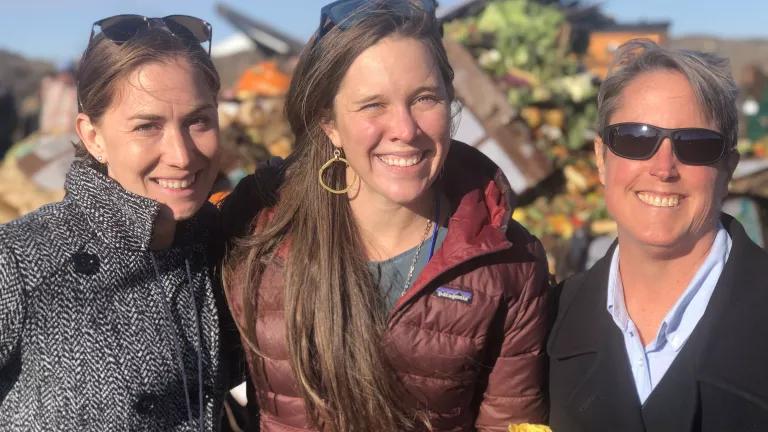Engaging Health Departments: Overview Guide
We outline some of the ways that health inspectors can help educate food facilities on how to prevent wasted food and donate surplus.

Many health departments deal with community health and food issues, including nutrition and food access, health and safety regulation of food facilities, and healthy eating and active living initiatives. Since health departments, particularly health inspectors, frequently interact with food facilities, they are uniquely positioned to educate and inform food facilities about food waste reduction and food donation. In this guide, we outline some of the ways that health inspectors can help educate food facilities on how to prevent wasted food and donate surplus food.
Background
Preventing food waste in food facilities
Preventing food from going to waste in the first place offers the greatest environmental benefits, which is why it is a major goal of NRDC’s Food Matters project. If food facilities, such as restaurants and cafeterias, adopt food waste prevention strategies, they realize not only environmental benefits, such as reducing greenhouse gases, but also financial benefits associated with avoiding waste.
Health inspectors can play an important role in educating food establishments to reduce food waste. Food in commercial kitchens spoil for many reasons, including improper storage, temperature, or inventory management. For example, spoilage might happen because there was no temperature or maintenance log of fridge temperatures, and the fridge wasn’t keeping the food cool enough. This guide provides outreach suggestions for health inspectors to communicate with businesses on food waste reduction, money savings, and increased food safety.
Misconceptions about safe food donation
Food insecurity is a pervasive challenge in the United States, with nearly 10.5 percent of Americans in 2020 needing assistance to meet their food needs. The donation of surplus food by grocery stores, restaurants, hotels, caterers, colleges, schools, sports facilities, food manufacturers, and other licensed food facilities is an important strategy for reducing the amount of food that is discarded and closing the meals gap in our communities.
Many food facilities do not have a good understanding of food donation protocols and existing liability protections that enable them to donate food safely. Food facilities may hold misconceptions such as that their city health inspector discourages donation or that they will be fined if they donate surplus food. Health inspectors are ideally positioned to dispel such myths, convey their city government’s interest in addressing food insecurity, and communicate directly with licensed food facilities to ensure that they have the information they need to donate food safely.
Using this Guide
To address these issues, NRDC developed this guide, which comprises tools and tips to assist health departments in helping the food facilities they work with to waste less food and donate more food safely. The guide includes three sections:
- Tips for success
- Training health inspectors
- Outreach and education materials for food facilities
Review the three sections of this guide and then decide:
- What is your group’s goal for health inspector or department engagement? The goal could be as simple as educating health inspectors about safe food donation or as intensive as creating materials for all health inspectors to give out during their inspections, running a pilot to test the materials, and tracking progress.
- Based on your goals, what training and outreach materials will you need? The outreach materials and tools in this guide are simply suggestions. Every city’s needs are different, and your approach might look different from what is outlined here. Use this guide as a starting point to make a plan and start getting buy-in!
Section 1: Tips for Success
Identify a staff champion
Cities often find it helpful to identify a champion on staff within the health department (often a health inspector) to help shape their inspector engagement strategy and coordinate within (and beyond) the health department. The champion will be key for building staff buy-in, answering questions, and overseeing the process for developing and disseminating guidance to food facilities (discussed below). For example, in Denver, a staff champion from the health inspection team became a core member of the city’s food waste team and was able to collaborate across strategies related to food waste in the city, beyond the initial health inspector training.
Get higher-level buy-in
Senior management buy-in is helpful for moving quickly and collaboratively among city departments and demonstrating success. We have a template letter to send to senior officials that can help you make the case that city health departments should prioritize food waste reduction strategies. Please e-mail foodmatters@nrdc.org for a draft letter template.
Consider the audience
People working in a busy kitchen might not have time to read a text-heavy brochure, whereas a manager in the office of a food establishment might have more time to read through a technical document. Managers also conduct staff trainings and introduce and enforce safety protocols. The key questions to consider are: What materials do we want to share? What is the correct audience for them? What form should the materials be in? For example, you could give a paper brochure or a fridge magnet with a dry-erase marker so that kitchen staff can easily track food waste interventions. Similarly, kitchens in food establishments often have many different languages spoken. What languages are most common in your city or food establishments? We’ve provided some translated materials and we encourage you to consider translation of materials into needed languages.
Set yourself up for measuring success
If the department is going to print outreach materials, such as a safe food donation brochure or magnet, how will you track how many materials were distributed, and how will you use those numbers to assess the initiative’s success and contribution toward achieving your goals? By creating impact metrics and an intentional data collection strategy at the onset, you will be able to determine whether the initiative is meeting your expectations and adjust accordingly. Some of the metrics from the Food Matters metrics tracking guide that might be relevant include:
- Number of health inspectors trained in food waste prevention and surplus food donation outreach
- Formal incorporation of food waste prevention and surplus food donation topics into
- Department of Health site-visit protocols
- Number of environmental health policies changed that remove barriers to food donation
- Amounts of food donated or food wasted at licensed food facilities before and after outreach by health inspectors
- Number of new and consistent businesses and institutions regularly donating appropriate surplus food
During inspections and food safety trainings, health inspectors could also be recording data. Some easy data that health inspectors can be asked to record on-site include:
- Number of copies of each material passed out during the inspection of a food facility
- Whether the inspector provided verbal education to the facility
- If the facility donates food or plans to donate food in the future
- Any specific questions that the facility might have had during inspection
- How much and what food was disposed of if there was a mandatory disposal during inspection
Section 2: Training Health Inspectors
Training health inspectors on the role that they can play to help reduce food waste and expand food donations is key to helping food facilities tackle food waste during routine inspections. The supplemental resources provided with this guide include a downloadable training deck and talking points for health inspectors called “A Training Guide for Health Inspectors: Food Waste Prevention and Safe Food Donations in Food Facilities.” The training deck includes suggestions for the presenter on how the training should be customized for the community and tips on how to best deliver the training.
You can use the downloadable deck and talking points accompanying this guide as a template for creating a training specific to your city. The document includes detailed talking points and can be modified to include information from your health department.
We suggest allowing time at the end of the training to discuss your city’s plans for developing and disseminating brochures, technical guidance, and other outreach materials discussed below. It is also important to include time for inspectors to raise questions and concerns, share related experiences from the field, and come away with a clear sense of why your city government supports wasted food prevention and increased food donation, the role of health inspectors in making that possible, and what the leadership is asking health inspectors to do.
Section 3: Outreach and Education Materials for Food Facilities
Departments can develop a range of outreach materials to educate food facilities about the issue of food waste, provide support for food waste prevention and food donation, and guide them toward additional resources—such as options for food scrap recycling. We recommend creating outreach materials before the health inspector training so you can review materials with inspectors during the training. All materials should be available online and, where appropriate, in print for distribution. The materials we recommend are detailed in Step 2.
Step 1: Develop materials for licensed food facilities
Supplemental materials provided online with this guide include templates and examples of a safe food donation trifold brochure, a safe food donation one-pager, technical guidance for food donation, and a letter of food waste prevention tips for managers. We also have examples of a temperature tracking template, a donation tracking template for food rescue organizations, and a senior officials buy-in letter template, which we can send via e-mail if you are interested.
Please feel free to modify the templated materials provided with this guide to address your local circumstances. Email us at foodmatters@nrdc.org for raw files for editing of the materials listed below.
Food waste prevention handout for food facility managers
- Languages: English, Spanish, Vietnamese*
- Audience: Food facility managers/owners
- How to use: Update links for your city. Provide this handout during routine health inspections or mailings and recommend that it be reviewed by managers or owners.
- Description: The template handout includes some facts and figures about food waste, cost savings associated with preventing food waste, and some tips for reducing food waste and saving money in the kitchen.
Safe food donation tri-fold brochure and safe food donation one-pager
- Languages: English (brochure and one-pager), Spanish (brochure and one-pager), Vietnamese*
- Audience: Brochure should go to the office; one-pager can go to kitchen or food-handling location
- How to use: The template brochure and one-pager are available for download. Send out via mailing or provide during routine inspections or trainings.
- Description: The sample safe food donation brochure examples are from Denver, Minneapolis, and Nashville, many of which used our template as a starting point. A template brochure is included for you to edit. Additionally, there is a one-pager version of the template so that it can be printed as a fridge magnet or a simplified handout with less text. Make sure your brochure/magnet text addresses the following topics concisely and clearly:
- Foods that are or are not eligible for donation
- Basic food safety parameters (e.g., required food temperatures, cooling parameters)
- Brief text about the federal Bill Emerson Good Samaritan Food Donation Act, which provides liability protection to food donors and federal tax incentives for food donation
- Organizations in your community that can pick up surplus food from licensed facilities and distribute it to people in need
- Options for recycling non-donatable food, such as composting
- City or health department contact information
Technical guidance on safe food donation
- Languages: English, Spanish, Vietnamese*
- Audience: Food facilities needing more information about safe food donations
- How to use: Post guidance on your city website so that facilities can find everything they need to know to donate food safely while meeting local regulatory requirements. Link to the guidance on the safe food donation brochure and one-pager.
- Description: The technical guidance template should include your agency’s regulations pertaining to safe food donation, including required time and temperature controls, food labeling, transportation, etc.
Once you have drafted the materials you want to provide to food facilities, ask a few local rescue organizations and food facilities to review them and provide feedback as to whether the materials are factual, appropriate, and useful. On the safe food donation guidance specifically, this consultation can also help build strong relationships between your department and food rescue organizations, which is key given that food rescuers also need to comply with local health regulations and will regularly interact with facilities that want to donate food.
*Please e-mail foodmatters@nrdc.org for undesigned Vietnamese translations of these materials.
Step 2: Create distribution plan and budget
The following tips may be helpful in honing your distribution plan for the outreach materials.
Estimating costs
The costs of this strategy are mostly printing costs. Those costs are driven by the number of licensed facilities in your community, the number of copies and outreach materials you want to have printed, and type of material (e.g., paper or magnet). Costs can also include graphic design services (if not using NRDC’s template and if in-house design capacity is not available), envelopes and postage, and staff capacity. We have typically found that the above costs total less than $5,000 for the safe food donation brochure in paper for a city with 1,500 to 2,000 licensed food facilities.
Distribution channels
Create a strategy at the onset to track how many brochures are distributed and to which facilities. Below are some options we have found helpful:
- Post the brochure and technical guidance on your Department of Health website or on other relevant city webpages.
- Mail the brochure to licensed food facilities and local stakeholder groups, such as the local restaurant or hospitality association, economic development agency, and food rescue organizations, and ask them to share the materials.
- Distribute the printed materials and add discussion of wasted food prevention and food donation to all routine food facility inspections and trainings, including the license approval process and first inspection packets for new food facilities. Keep an eye out for areas of confusion that may require additional information to ensure that facilities can donate with confidence and in line with your local regulations. Ideally, incorporate a question such as “Have you donated food to a food rescue organization in the past month?” into your site visit protocol. This will help ensure that food donation issues are discussed and provide the basis for tracking the impact of your communication efforts.
Conclusion
This guide provides just a few of the ways that health departments can act on food waste reduction and none of these strategies are a one-size-fits-all solution. Consider how you can adapt this approach to fit your community’s needs and what other city departments you can work with to make further progress on food waste reduction. For other city-level food waste reduction strategies and to learn more about NRDC’s Food Matters Initiative, please visit our website.
Do you have feedback or ideas to make this training or guide better? We would love to hear from you! Please e-mail foodmatters@nrdc.org.
Additional Resources
For health departments or other city agencies wanting to know more, the links below provide additional information on resources relevant to wasting less food and donating food:


